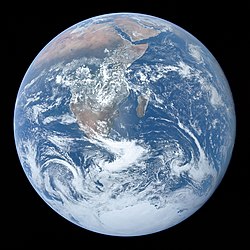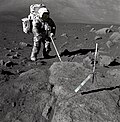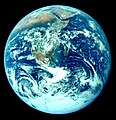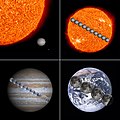File:Earth 17.jpg

Original file (2,700 × 2,701 pixels, file size: 6.26 MB, MIME type: image/jpeg)
Captions
Captions
Summary[edit]
| The Blue Marble
|
|||||||||||||||||||||||||||||||||||||||||||||||||||||||||||||||
|---|---|---|---|---|---|---|---|---|---|---|---|---|---|---|---|---|---|---|---|---|---|---|---|---|---|---|---|---|---|---|---|---|---|---|---|---|---|---|---|---|---|---|---|---|---|---|---|---|---|---|---|---|---|---|---|---|---|---|---|---|---|---|---|
| Author |
NASA/Apollo 17 crew; taken by either Harrison Schmitt or Ron Evans |
||||||||||||||||||||||||||||||||||||||||||||||||||||||||||||||
| Photographer |
|
||||||||||||||||||||||||||||||||||||||||||||||||||||||||||||||
| Title | |||||||||||||||||||||||||||||||||||||||||||||||||||||||||||||||
| Part of |
Apollo 17 |
||||||||||||||||||||||||||||||||||||||||||||||||||||||||||||||
| Object type |
photograph |
||||||||||||||||||||||||||||||||||||||||||||||||||||||||||||||
| Genre |
astrophotography |
||||||||||||||||||||||||||||||||||||||||||||||||||||||||||||||
| Description |
العربية: صورة الگُلَّة (البلية) الزرقاء الشهيرة التي تعتبر أول صورة لمنظر الأرض الكامل. إلتُقطت الصورة في 7 كانون الأوَّل (ديسمبر) 1972 بواسطة طاقم مركبة الفضاء الأمريكيَّة أپولو 17 عند مغادرتهم مدار الأرض لِلقمر من على بعد حوالي 29,400 كيلومتر عن سطح الأرض. إلتقط الطاقم صورة الكوكب الأزرق بِشكلٍ مُتقنٍ حيثُ كانت الشمس من ورائهم وهو ما سمح بِإضائة مُمتازة لِكوكب الأرض، حيثُ تظهر أفريقيا، والقارَّة القطبيَّة الجنوبيَّة (أنتاركتيكا) وشبه الجزيرة العربيَّة.
Deutsch: „Blue Marble“, die während des Fluges von Apollo 17 zum Mond am 7. Dezember 1972 entstandene Fotoaufnahme von der Erde
English: "The Blue Marble" is a famous photograph of the Earth taken on December 7, 1972, by the crew of the Apollo 17 spacecraft en route to the Moon at a distance of about 29,400 kilometres (18,300 mi). It shows Africa, Antarctica, and the Arabian Peninsula.
فارسی: «تیلهٔ آبی» تصویر معروفی از زمین که در ۷ دسامبر ۱۹۷۲ توسط خدمهٔ فضاپیمای آپولو ۱۷ در مسیر ماه در حدود ۲٬۹۰۰ کیلومتری زمین گرفته شده است و قسمتهایی از آفریقا، جنوبگان و شبه جزیرهٔ عرب را نشان میدهد.
Suomi: Sininen marmorikuula.
Français : «La bille bleue» : Photo de l'Afrique, de l'Antarctique et de la péninsule Arabique prise en route pour la lune par Harrison Schmitt ou Ron Evans lors de la mission Apollo 17 le 7 décembre 1972. Ce vol a été le dernier à quitter l'orbite terrestre, et le seul au cours duquel un géologue, Harrison Schmitt, s'est rendu sur la lune.
हिन्दी: "द ब्लू मार्बल" लगभग 29,400 kilometres (18,300 mi) की ऊँचाई पर चन्द्रमा की यात्रा पर गये अंतरिक्षयान अपोलो १७ के सदस्यों द्वारा दिसम्बर २००७ को लिया गया प्रसिद्ध चित्र है। इसमें अफ़्रीका, अंटार्कटिका और अरबी प्रायद्वीप दिखाई दे रहे हैं।
Italiano: Famosa fotografia della Terra ripresa il 7 dicembre 1972 dall'equipaggio della missione Apollo 17 diretta verso la Luna, da una distanza di circa 29.400 km.
Македонски: „Сината џамлија“ е позната фотографија на Земјата направена на 7 декември 1972 од екипажот на вселенското летало Аполо 17 патувајќи кон Месечината. Сликана е на растојание од 29.400 километри, а на неа се гледаат Африка, Антарктикот и Арапскиот Полуостров.
Português: A Bolinha Azul é uma fotografia famosa da Terra tirada a 7 de dezembro de 1972 durante a missão Apollo 17, quando se encontrava a caminho da Lua e a 29,400 quilómetros da Terra.
Українська: Блакитна іграшкова куля — відома фотографія Землі, зроблена 7 грудня 1972 року командою космічного апарату «Аполлон-17».
中文:蓝色弹珠 是一张在1972年12月7日由阿波罗17号太空船船员所拍摄的著名地球照片。当时太空船正运行至距离地球29,400公里(18,300英里)之处。
日本語: ザ・ブルー・マーブルは、月へ向かうアポロ17号のクルーが1972年12月7日に撮影した有名な地球の写真。29,400km離れた距離から撮影された。アフリカ、アラビア半島、南極大陸、インド洋などを捉えている。
Magyar: „Blue Marble“, valami
Čeština: Modrá skleněnka je fotografie planety Země, kterou 7. prosince 1972 pořídila posádka Apolla 17 ze vzdálenosti zhruba 29 400 kilometrů. |
||||||||||||||||||||||||||||||||||||||||||||||||||||||||||||||
| Date |
7 December 1972 date QS:P571,+1972-12-07T00:00:00Z/11 |
||||||||||||||||||||||||||||||||||||||||||||||||||||||||||||||
| Source | https://web.archive.org/web/20160112123725/http://grin.hq.nasa.gov/ABSTRACTS/GPN-2000-001138.html (image link); see also https://www.nasa.gov/multimedia/imagegallery/image_feature_329.html | ||||||||||||||||||||||||||||||||||||||||||||||||||||||||||||||
| Other versions |
Other versions:
Derivative works:
|
||||||||||||||||||||||||||||||||||||||||||||||||||||||||||||||
This image or video was catalogued by Johnson Space Center of the United States National Aeronautics and Space Administration (NASA) under Photo ID: AS17-148-22727. This tag does not indicate the copyright status of the attached work. A normal copyright tag is still required. See Commons:Licensing. Other languages:
العربية ∙ беларуская (тарашкевіца) ∙ български ∙ català ∙ čeština ∙ dansk ∙ Deutsch ∙ English ∙ español ∙ فارسی ∙ français ∙ galego ∙ magyar ∙ հայերեն ∙ Bahasa Indonesia ∙ italiano ∙ 日本語 ∙ македонски ∙ മലയാളം ∙ Nederlands ∙ polski ∙ português ∙ русский ∙ sicilianu ∙ slovenščina ∙ Türkçe ∙ українська ∙ 简体中文 ∙ 繁體中文 ∙ +/− |
This image or video was catalogued by Great Images in NASA of the United States National Aeronautics and Space Administration (NASA) under Photo ID: GPN-2000-001138. This tag does not indicate the copyright status of the attached work. A normal copyright tag is still required. See Commons:Licensing. Other languages:
العربية ∙ беларуская (тарашкевіца) ∙ български ∙ català ∙ čeština ∙ dansk ∙ Deutsch ∙ English ∙ español ∙ فارسی ∙ français ∙ galego ∙ magyar ∙ հայերեն ∙ Bahasa Indonesia ∙ italiano ∙ 日本語 ∙ македонски ∙ മലയാളം ∙ Nederlands ∙ polski ∙ português ∙ русский ∙ sicilianu ∙ slovenščina ∙ Türkçe ∙ українська ∙ 简体中文 ∙ 繁體中文 ∙ +/− |
Assessment[edit]

|
This is one of the images forming part of the Valued image set: Earth from space on Wikimedia Commons. The image set has been assessed under the valued image set criteria and is considered the most valued set on Commons within the scope:
You can see its nomination at Commons:Valued image candidates/Earth from space. |

|
This image was selected as picture of the day on Bengali Wikipedia.
|
Licensing[edit]
| Public domainPublic domainfalsefalse |
| This file is in the public domain in the United States because it was solely created by NASA. NASA copyright policy states that "NASA material is not protected by copyright unless noted". (See Template:PD-USGov, NASA copyright policy page or JPL Image Use Policy.) |  | |
 |
Warnings:
|
Additional information[edit]
Source: http://nssdc.gsfc.nasa.gov/imgcat/html/object_page/a17_h_148_22727.html
| “ | Earth - Apollo 17
Full Earth showing Africa and Antarctica Apollo 17 hand-held Hasselblad picture of the full Earth. This picture was taken on 7 December 1972, as the spacecraft traveled to the moon as the last of the Apollo missions. A remarkably cloud-free Africa is at upper left, stretching down to the center of the image. Saudi Arabia is visible at the top of the disk and Antarctica and the south pole are at the bottom. Asia is on the horizon is at upper right. The Earth is 12,740 km (7,920 mi) in diameter. (Apollo 17, AS17-148-22727) Location & Time Information |
” |
File history
Click on a date/time to view the file as it appeared at that time.
| Date/Time | Thumbnail | Dimensions | User | Comment | |
|---|---|---|---|---|---|
| current | 20:25, 1 May 2021 |  | 2,700 × 2,701 (6.26 MB) | Cowfire (talk | contribs) | File:The Earth seen from Apollo 17.jpg cropped 10 % horizontally, 10 % vertically using CropTool with precise mode. |
You cannot overwrite this file.
File usage on Commons
The following 2 pages use this file:
- File:Earth 17.jpg
- File:Earth 17o.jpg (file redirect)
File usage on other wikis
The following other wikis use this file:
- Usage on en.wikipedia.org
Metadata
This file contains additional information such as Exif metadata which may have been added by the digital camera, scanner, or software program used to create or digitize it. If the file has been modified from its original state, some details such as the timestamp may not fully reflect those of the original file. The timestamp is only as accurate as the clock in the camera, and it may be completely wrong.
| Orientation | Normal |
|---|---|
| Horizontal resolution | 300 dpi |
| Vertical resolution | 300 dpi |
| Software used | Adobe Photoshop CS Windows |
| File change date and time | 13:09, 13 May 2005 |
| Color space | sRGB |
| Image width | 3,000 px |
| Image height | 3,002 px |
| Date and time of digitizing | 08:09, 13 May 2005 |
| Date metadata was last modified | 08:09, 13 May 2005 |
Structured data
Items portrayed in this file
depicts
- Extracted images
- Artworks with digital representation of missing same main subject
- Photographs with Wikidata item
- Photographs with Wikidata item missing author
- Artworks digital representation of 2D work
- Files from NASA with known IDs
- Images used in valued image sets
- Featured pictures on Wikipedia, Bengali
- PD NASA
- Featured pictures on Wikipedia, Croatian
- Featured pictures on Wikipedia, German
- Photos taken with Hasselblad
- Astronomy Picture of the Day
- Great Images in NASA






















